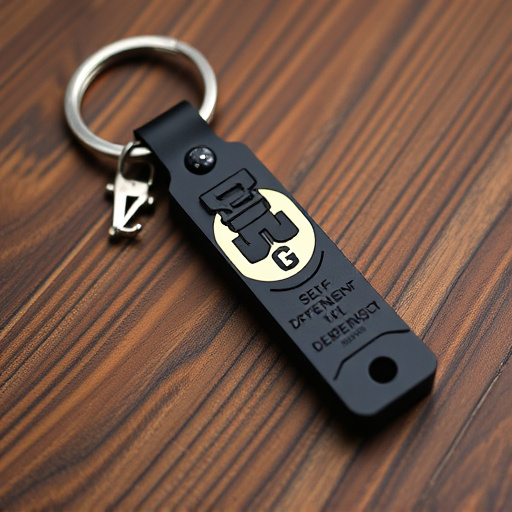Tactical keyring self-defense tools, made from durable materials like high-quality stainless steels and reinforced nylon, offer a blend of portability and functionality. With ergonomic design and non-slip grip, these compact devices provide effective personal protection, suitable for everyday carry and outdoor use. Responsible carrying involves understanding local laws, practicing safe storage, and adhering to regulations on concealed weapons.
In today’s unpredictable world, self-defense is a paramount concern. One innovative solution gaining traction is the tactical keyring—a compact, discreet weapon designed for quick deployment. This article explores the crucial elements of effective self-defense keyrings, focusing on durable materials and ergonomic design. We’ll delve into the significance of robust construction using high-quality, long-lasting materials, while navigating legal considerations to ensure responsible carry practices.
- Understanding the Need for Tactical Keyring Self-Defense
- Key Materials and Their Durability in Design
- Effective Grip and Ergonomics for Quick Deployment
- Legal Considerations and Responsible Carry Tips
Understanding the Need for Tactical Keyring Self-Defense
In today’s world, personal safety is a top concern, and individuals are increasingly seeking practical solutions to protect themselves in various situations. This need has given rise to innovative concepts like tactical keyring self-defense tools, offering a unique blend of functionality and portability. These compact devices are designed to provide users with an extra layer of security when facing potential threats.
Tactical keyrings equipped with self-defense features cater to the growing demand for durable materials that can withstand harsh conditions. Crafted from high-quality steels and robust alloys, these keychains serve as versatile weapons capable of deterring attacks. Their compact design allows them to fit comfortably on a keychain, ensuring users have access to a defense mechanism whenever needed. The use of durable materials guarantees their longevity, making them reliable tools for self-preservation.
Key Materials and Their Durability in Design
When designing tactical keyring self-defense tools, choosing durable materials is paramount to ensure their longevity and effectiveness. The key components must be able to withstand regular use, potential impact, and exposure to various environments, from outdoor adventures to everyday carry situations. High-quality stainless steels, such as 410 or 304 grade, are popular choices for their resistance to corrosion and ability to maintain a sharp edge. These materials offer excellent durability, making them ideal for creating robust and reliable blades on tactical keychains.
Additionally, synthetic materials like reinforced nylon or high-performance polymers are increasingly favored for their light weight, strength, and impact resistance. These durable options are less prone to chipping or breaking than traditional metal components, further enhancing the overall durability of the self-defense keyring.
Effective Grip and Ergonomics for Quick Deployment
An effective self-defense keyring starts with a tactical grip design that prioritizes ergonomics and quick deployment. The keyring should fit comfortably in your hand, allowing for a secure yet swift grasp, crucial during moments of unexpected danger. Durable materials like high-quality stainless steel or aircraft-grade aluminum are essential for the construction to ensure longevity and reliability in various conditions. These robust materials not only withstand regular use but also provide the necessary traction and texture to prevent slipping when every second counts.
The grip should be designed with a non-slip pattern, enabling users to firmly hold onto the keyring even under stress or in slippery environments. This ensures that the tool can be deployed promptly without any hindrance, giving you an advantage in self-defense scenarios. Ergonomic design considerations also include the overall size and weight of the keyring, which should be compact enough to carry on your keys yet robust enough to deliver a strong defensive blow when needed.
Legal Considerations and Responsible Carry Tips
When carrying a tactical keyring designed for self-defense, it’s paramount to be aware of legal restrictions and responsible carry practices. Each jurisdiction has its own laws regarding concealed weapons, so understanding your local regulations is crucial before equipping yourself with such a device. Check if your area falls under the category of permit or license-required states, as well as any restrictions on specific types of self-defense tools.
Durable materials used in the construction of the keyring weapon play a significant role in responsible carry. Opting for high-quality metal components ensures reliability and longevity, making it less likely to fail when needed most. Additionally, consider factors like size and weight, ensuring the device fits comfortably and discreetly on your person without causing discomfort or attracting unnecessary attention. Responsible carrying includes keeping the device secured at all times, storing it in a safe location, and being mindful of public safety by avoiding situations where its use could endanger others.
The tactical keyring self-defense grip design combines functionality, durability, and legal considerations, making it a practical choice for those seeking an effective personal defense tool. By utilizing robust materials like high-strength steel and durable plastic, these keychains offer exceptional resistance and longevity. Their ergonomic designs ensure swift deployment, allowing users to defend themselves with precision and confidence. Remember, responsible carrying practices and understanding local laws are paramount when embracing this innovative self-defense solution.
